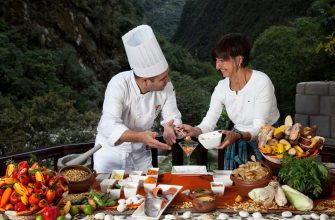Food enthusiasts are always on the lookout for new culinary experiences. The world is filled with unusual cuisines that offer exotic flavors and unique ingredients, challenging our taste buds and expanding our gastronomic horizons. In this guide, we’ll explore some of the most unusual cuisines from around the world.
- Icelandic Cuisine: A Taste of the Arctic
- Peruvian Cuisine: A Fusion of Flavors
- Ethiopian Cuisine: A Communal Experience
- Korean Temple Cuisine: A Spiritual Feast
- Mongolia: A Nomadic Cuisine
- Australian Bush Tucker: Food from the Outback
- The Exotic Delights of Madagascar
- The Arctic Delicacies of Greenland
- Conclusion: Celebrating Culinary Diversity
Icelandic Cuisine: A Taste of the Arctic
Iceland’s cuisine reflects its harsh environment and history of survival. Fermented shark (hákarl) and boiled sheep’s head (svið) are among the most intriguing dishes. Seaweed and dried fish (harðfiskur) are also popular, while Skyr, a creamy yogurt-like dairy product, is a must-try.
Peruvian Cuisine: A Fusion of Flavors
Peruvian cuisine is a fascinating blend of indigenous, Spanish, African, Chinese, and Japanese influences. The national dish, ceviche, is made from raw fish marinated in citrus juice. Guinea pig (cuy) is another popular dish, often served whole and roasted. Don’t forget to try the unique Amazonian fruit camu camu, packed with vitamin C.
Ethiopian Cuisine: A Communal Experience
Ethiopian cuisine is characterized by its spicy stews (wats) and the sourdough flatbread injera. Meals are often served on a communal platter, with diners using their hands and the injera to scoop up the food. Coffee lovers should experience a traditional Ethiopian coffee ceremony, which showcases the country’s rich coffee culture.
Korean Temple Cuisine: A Spiritual Feast
Korean temple cuisine, practiced by Buddhist monks, focuses on using natural, locally-sourced ingredients while avoiding pungent flavors like garlic and onion. Temple food is strictly vegetarian, with dishes like vegetable pancakes (jeon) and rice wrapped in lotus leaves (yeonnipbap). It’s a culinary experience that nourishes both body and soul.
Mongolia: A Nomadic Cuisine
Mongolian cuisine is shaped by its nomadic traditions and harsh climate. Meat and dairy products dominate the menu due to the country’s extensive livestock farming. Try airag, a fermented mare’s milk, or boodog, a unique dish where meat (usually goat) is cooked inside its own skin with hot stones.
Australian Bush Tucker: Food from the Outback
Australia’s indigenous culture offers a unique range of food known as bush tucker. This includes native fruits like the tart quandong, protein-rich witchetty grubs, and lean game meats like kangaroo and emu. It’s a forager’s delight and a testament to human adaptability.
The Exotic Delights of Madagascar
Madagascar’s culinary scene is a melting pot of African, Arab, and French influences. The country’s unique fauna and flora contribute to its unusual cuisine. Zebu, a type of humped cattle, is a staple, while ravitoto, a dish made of pork and cassava leaves, is a must-try.
The Arctic Delicacies of Greenland
Greenland’s Inuit cuisine is built around what’s locally available: seafood, birds, and land mammals. Traditional dishes like suaasat (a meaty soup) and kiviak (fermented birds) may be an acquired taste. The adventurous can try mattak, raw whale skin with a hint of blubber.
Conclusion: Celebrating Culinary Diversity
Tasting unusual cuisines can be a doorway to understanding diverse cultures. These culinary experiences, as exotic as they may seem, underline our shared human creativity and adaptability. They remind us of the endless ways we can nourish ourselves, celebrate our cultures, and appreciate our planet’s bounty. So, venture forth, eat, and enjoy the world’s most unusual cuisines!
